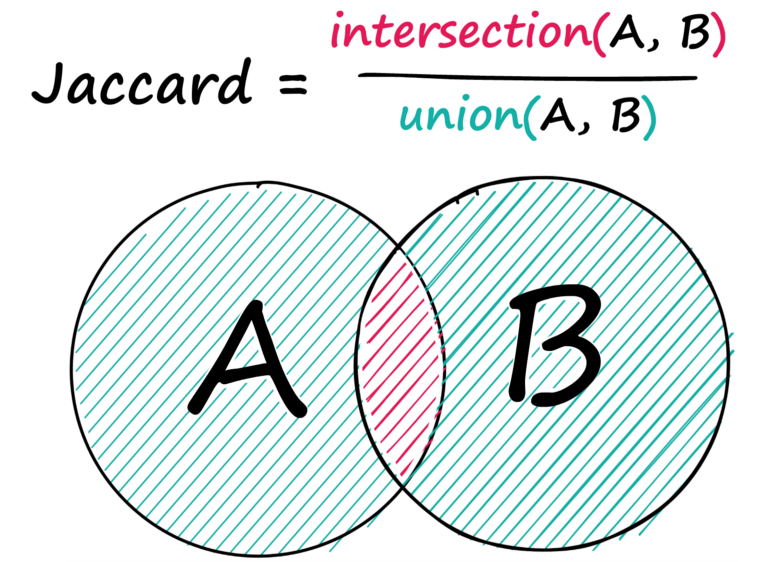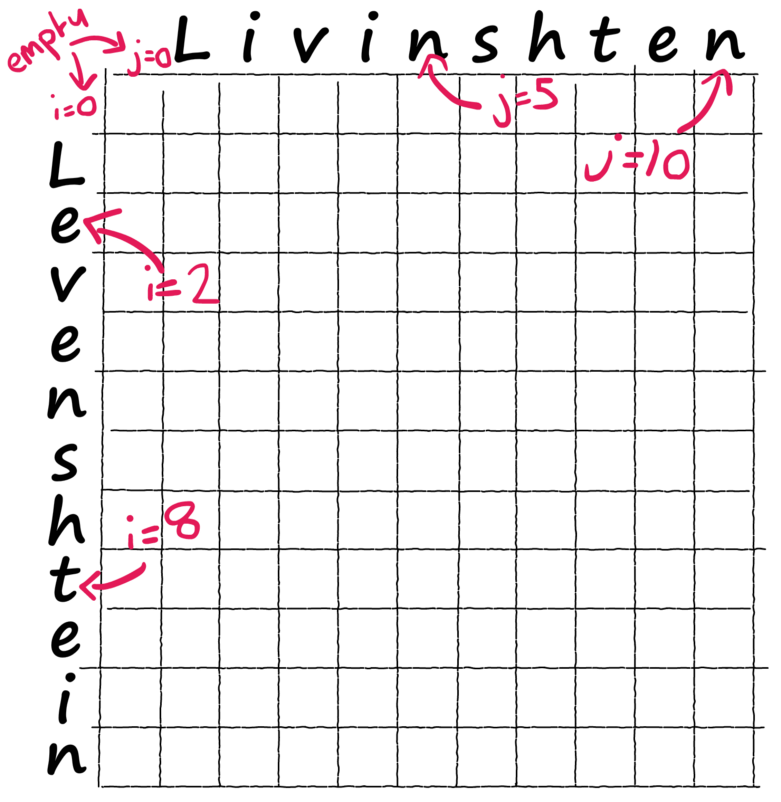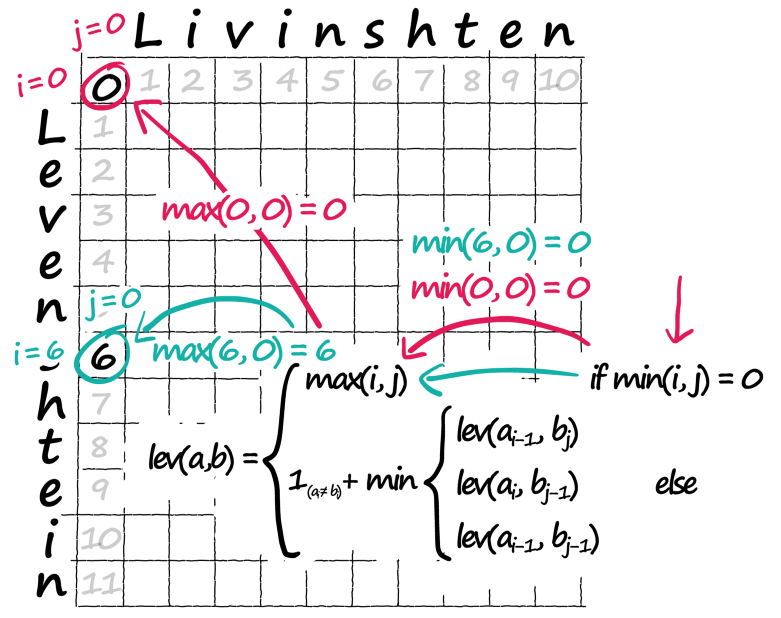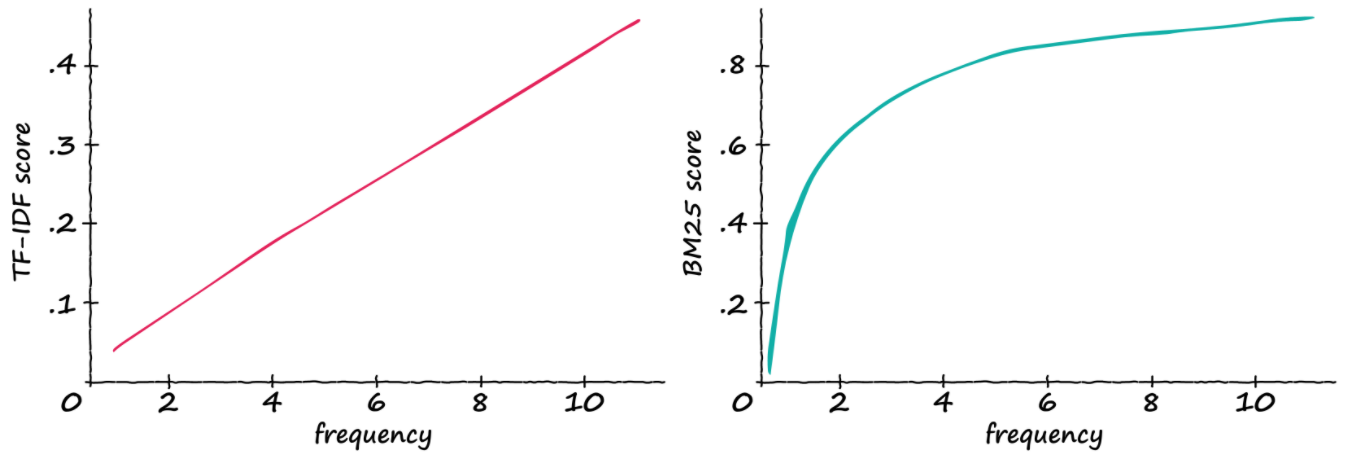原文标题:Semantic Search: Measuring Meaning From Jaccard to Bert
作者:James Briggs
原文地址:https://towardsdatascience.com/semantic-search-measuring-meaning-from-jaccard-to-bert-a5aca61fc325
注:只挑选了干货部分进行翻译
目录
前言
相似性搜索(Similarity search)是人工智能和机器学习中发展最快的领域之一。其核心是将相关信息片段匹配在一起的过程。
相似性搜索是一个复杂的主题,有无数的技术来构建有效的搜索引擎。在本文中,我们将介绍这些技术中最有趣、最强大的,特别关注语义检索(semantic search)。我们将学习它们如何工作,它们的优势,以及如何自己实现它们。
1. 传统搜索
- Jaccard Similarity
- w-shingling
- Pearson Similarity
- Levenshtein距离
- 标准化谷歌距离(Normalized Google Distance)
所有这些都是用于相似性搜索的优秀指标,其中我们将介绍三个最流行的指标:Jaccard相似性、w-shingling和Levenshtein距离。
1.1 Jaccard Similarity
Jaccard相似性是一个简单,但有些时候很有用的相似性度量手段。
给定两个序列,A和B,我们求出两者之间共有的元素的数量,然后除以两个序列中的元素总数。
Jaccard相似度度量两个序列在两个序列的并集上的交集:

下面是一段示例代码:
a = [0, 1, 2, 3, 3, 3, 4]
b = [7, 6, 5, 4, 4, 3]
# convert to sets
a = set(a)
b = set(b)
# find the number of shared values between sets
shared = a.intersection(b)
# find the total number of values in both sets
total = a.union(b)
# and calculate Jaccard similarity
len(shared) / len(total)
在这里,我们确定了两个序列之间的两个共享唯一整数,3和4,这两个序列中总共有10个整数,其中8个是唯一值
由
2
/
8
2/8
2/8 得到Jaccard相似性得分为0.25。
我们也可以对文本数据执行相同的操作,我们所做的就是用单词替换整数。
计算两个句子a和b之间的Jaccard相似度:

a = "his thought process was on so many levels that he gave himself a phobia of heights".split()
b = "there is an art to getting your way and throwing bananas on to the street is not it".split()
c = "it is not often you find soggy bananas on the street".split()
a = set(a)
b = set(b)
c = set(c)
def jac(x: set, y: set):
shared = x.intersection(y) # selects shared tokens only
return len(shared) / len(x.union(y)) # union adds both sets together
jac(a, b) # 0.03225806451612903
jac(b, c) # 0.35
我们发现句子b和c的得分要高得多,正如我们预期的那样。现在,它并不是完美的——两个除了“the”、“a”、“is”等词之外什么都没有的句子可能会返回很高的Jaccard分数,尽管语义不同。
这些缺点可以通过预处理技术部分解决,如使用停用词表,词干/词形还原等。然而,我们很快就会看到,有些方法完全避免了这些问题。
1.2 w-Shingling
另一种类似的技术是w-Shingling。
w-Shingling使用完全相同的取交集,并集逻辑,但使用“shingles”。
个人理解就是n-grams
The w denotes the number of tokens in each shingle in the set.
句子A的2-shingle看起来像:a = {‘his thought’, ‘thought process’, ‘process is’, …}
就是取了句子的2-gram。
# 句子分词
a = "his thought process was on so many levels that he gave himself a phobia of heights".split()
b = "there is an art to getting your way and throwing bananas on to the street is not it".split()
c = "it is not often you find soggy bananas on the street".split()
a_shingle = set([' '.join([a[i], a[i+1]]) for i in range(len(a)) if i != len(a)-1])
b_shingle = set([' '.join([b[i], b[i+1]]) for i in range(len(b)) if i != len(b)-1])
c_shingle = set([' '.join([c[i], c[i+1]]) for i in range(len(c)) if i != len(c)-1])
# 仍然可用杰卡德距离的公式计算,只不过每个元素由单词变为了2-gram
jac(a_shingle, b_shingle) # 0.0
jac(b_shingle, c_shingle) # 0.125
# 展示两句中匹配的shingles
b_shingle.intersection(c_shingle)
# {'bananas on', 'is not', 'the street'}
1.3 Levenshtein Distance
莱文斯坦距离,又称Levenshtein距离,是编辑距离的一种。指两个字串之间,由一个转成另一个所需的最少编辑操作次数。允许的编辑操作包括将一个字符替换成另一个字符,插入一个字符,删除一个字符。
这是一道经典的动态规划算法题,可前往力扣自行练习。
题目链接:https://leetcode-cn.com/problems/edit-distance/。
Levenshtein距离公式:

变量a和b代表两个字符串,i和j分别代表a和b中的字符位置。

下标从1开始,索引0将代表空字符串

使用Wagner-Fischer matrix来计算两个字符串的莱温斯坦距离。
a = ' Levenshtein'
b = ' Livinshten' # we include empty space at start of each word
import numpy as np
# initialize empty zero array
lev = np.zeros((len(a), len(b)))
lev[i][j] 表示a[0:i]变换到b[0:j]的最小操作次数。

首先处理dp表的边界。很容易理解,一个空的字符串要变成另一个字符串,操作数必然是非空字符串的长度。
for i in range(len(a)):
for j in range(len(b)):
# if i or j are 0
if min([i, j]) == 0:
# we assign matrix value at position i, j = max(i, j)
lev[i, j] = max([i, j])

内部元素的计算:

for i in range(len(a)):
for j in range(len(b)):
# we did this before (for when i or j are 0)
if min([i, j]) == 0:
lev[i, j] = max([i, j])
else:
# calculate our three possible operations
x = lev[i-1, j] # 删除
y = lev[i, j-1] # 插入
z = lev[i-1, j-1] # 替换
# take the minimum (eg best path/operation)
lev[i, j] = min([x, y, z])
# and if our two current characters don't match, add 1
if a[i] != b[j]:
# if we have a match, don't add 1
lev[i, j] += 1
这篇博客没有讲清楚算法的原理,只是用画图展示了计算过程。提供的代码,耗时和内存也很糟糕。
下面讲一讲基本的动态规划思路:
指针
i
i
i指向word1, 指针
j
j
j指向word2
- d p [ 0 ] [ 0 ] dp[0][0] dp[0][0]表示word1和word2都是空的字符串
- d p [ i ] [ j ] dp[i][j] dp[i][j]表示word1的前i个字符转换成word2的前j个字符所需要的最少操作步数
注意只看操作的word1的字符范围,不看操作后的word1的长度!并且我们始终操作word1。
确定递推公式
当word1[i-1] == word2[j-1]时,什么也不做,dp[i][j] = dp[i-1][j-1]
当word1[i-1] != word2[j-1]时, 有三种情况:
1. 什么时候插入?
已经将word1的前i个字符转换为word2的前j-1个字符了(最小操作数为dp[i][j-1])
只需在word1的第i个字符后面插入word2[j]
2. 什么时候删除?
已经将word1前i-1个字符转换为word2的前j个字符(最小操作数为dp[i-1][j])
只需要删除word1[i-1], 相当于dp[i-1][j]加上一次删除操作
3. 什么时候替换?
已经将word1的前i-1个字符转换成word2的前j-1个字符(最小操作数为dp[i-1][j-1])
只需要将word1的第i个字符替换成word2的第j个字符
2. 向量相似度检索
- TF-IDF
- BM25
- word2vec/doc2vec
- BERT
- USE
这些基于向量的方法是相似度搜索领域的最优方法。
我们将介绍基于TF-IDF、BM25和BERT的方法,因为它们是最常见的方法,并且涵盖稀疏和密集向量表示。
2.1 TF-IDF
信息检索领域的经典方法,诞生于1970s。
关于TF-IDF这部分,也可以参考我的博客:
IR&IE笔记:倒排索引表与布尔模型
IR&IE笔记:向量空间模型与扩展的向量空间模型
TF(term frequency)部分计算一个词语在一个文档中出现的次数,并将其除以该文档中的词语总数。
T
F
=
f
(
q
,
D
)
f
(
t
,
D
)
\Large TF = \frac{f(q, D)}{f(t, D)}
TF=f(t,D)f(q,D)
- f ( q , D ) f(q, D) f(q,D): q在文档D中出现的次数
- f ( t , D ) f(t, D) f(t,D): 文档d的词数

“bananas"是一个比较有信息含量的查询词,计算所有文档的TF('bananas', D),可以找出"bananas"出现频率较高的文档。但是如果query中还包含了一些常用词呢?如"the”、“is"或"it"这样的词。假如我们搜索"is bananas”,可能含有更多"is"的文档"is is is is is"就会排在更前面。但显然不是我们想要的。
某个单词出现次数越小,那文档中出现此单词的概率越小,则信息量越高。理想情况下,我们希望稀有词,即带有更多信息的词的匹配得分更高。因此我们需要第二个指标IDF,逆向文档频率。
IDF(The Inverse Document Frequency)衡量了一个单词在所有文档中的非常见程度。
I
D
F
=
l
o
g
N
N
(
q
)
\displaystyle \Large IDF = log \frac{N}{N(q)}
IDF=logN(q)N
N
(
q
)
N(q)
N(q): 包含词项
q
q
q的文档的数量

如下图所示,假如我们同时搜索"is"和"forest"这两个词,首先计算一次两个词的IDF值,再计算每个文档的TF('is', D)and TF('forest', D),将TF与IDF相乘得到每篇文档的TF-IDF值。

可以发现,尽管"is"在每篇文档的TF值较大,但IDF值为0,TF-IDF值还是帮助我们找到了信息量更大的,包含"forest"的文档。
原博客提供的代码有误,修正后的代码如下:
a = "purple is the best city in the forest".split()
b = "there is an art to getting your way and throwing bananas on to the street is not it".split()
c = "it is not often you find soggy bananas on the street".split()
import numpy as np
def tfidf(word):
tf = []
count_n = 0
for sentence in [a, b, c]:
t_count = 0
# calculate TF
for x in sentence:
if word == x:
t_count += 1
tf.append(t_count/len(sentence))
# count number of docs for IDF
count_n += 1 if word in sentence else 0
idf = np.log10(len([a, b, c]) / count_n)
return [round(_tf*idf, 2) for _tf in tf]
tfidf_a, tfidf_b, tfidf_c = tfidf('forest')
print(f"TF-IDF a: {tfidf_a}\nTF-IDF b: {tfidf_b}\nTF-IDF c: {tfidf_c}")
看起来TF-IDF本身就是一个检索算法了,那么,向量相似性检索从哪里来的呢?
根据所有的文档,维护一个词汇表。
一个文档,就可以用其所有单词的TF-IDF值表示成为一个向量,向量的长度为词表大小。

示例代码如下:
vocab = set(a+b+c)
# initialize vectors
vec_a = []
vec_b = []
vec_c = []
for word in vocab:
tfidf_a, tfidf_b, tfidf_c = tfidf(word)
vec_a.append(tfidf_a)
vec_b.append(tfidf_b)
vec_c.append(tfidf_c)
print(vec_a)
# [0.0, 0.0, 0.0, 0.0, 0.0, 0.48, 0.0, 0.0, 0.48, 0.0, 0.48, 0.48, 0.0, 0.0, 0.0, 0.0, 0.48, 0.0, 0.0, 0.0, 0.0, 0.0, 0.0, 0.0, 0.0]
值得注意的是,vocab的大小很容易在20K+范围内,因此使用这种方法生成的向量非常稀疏,这意味着我们无法编码任何语义。
2.2 BM25
Okapi BM25是TF-IDF的改进算法,基于文档长度对结果进行标准化。
假设我们有两篇500词的文章,发现A提到“丘吉尔”六次,B提到“丘吉尔”十二次——我们是否应该认为A有一半B的相关性?
大概不会。
BM25通过改进TF-IDF的公式解决了这个问题。

先来看TF部分

再来看IDF部分

随着查询词在句子中的频率提升,两个算法分数的直观对比如下所示。
TF-IDF分数随着相关单词的数量线性增加。因此,如果频率加倍,TF-IDF分数也会加倍。
而BM25的分数,不会在词频较高时线性增加。

计算BM25的分数并构建词向量的示例代码如下:
a = "purple is the best city in the forest".split()
b = "there is an art to getting your way and throwing bananas on to the street is not it".split()
c = "it is not often you find soggy bananas on the street".split()
d = "green should have smelled more tranquil but somehow it just tasted rotten".split()
e = "joyce enjoyed eating pancakes with ketchup".split()
f = "as the asteroid hurtled toward earth becky was upset her dentist appointment had been canceled".split()
docs = [a, b, c, d, e, f]
import numpy as np
avgdl = sum(len(sentence) for sentence in [a,b,c,d,e,f]) / len(docs)
N = len(docs)
def bm25(word, sentence, k=1.2, b=0.75):
freq = sentence.count(word) # or f(q,D) - freq of query in Doc
tf = (freq * (k + 1)) / (freq + k * (1 - b + b * (len(sentence) / avgdl)))
N_q = sum([doc.count(word) for doc in docs]) # number of docs that contain the word
idf = np.log(((N - N_q + 0.5) / (N_q + 0.5)) + 1)
return round(tf*idf, 4)
vocab = set(a+b+c+d+e+f)
vec = []
# we will create the BM25 vector for sentence 'a'
for word in vocab:
vec.append(bm25(word, a))
print(vec)
同样,BM25能算出的也是稀疏向量。我们将无法对语义进行编码,而是将重点放在语法上。
2.3 BERT
这部分作者主要使用了SBERT,SBERT可见我的这篇博客:Sentence-BERT论文阅读笔记






















 956
956











 被折叠的 条评论
为什么被折叠?
被折叠的 条评论
为什么被折叠?








